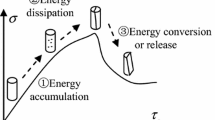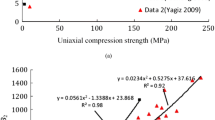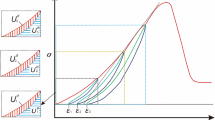Abstract
Brittleness is an important characteristic of rocks, for it has a strong influence on the failure process no matter from perspective of facilitating rock breakage or controlling rock failure when rocks are being loaded. Various brittleness criteria have been proposed to describe rock brittleness. In this paper, the existing brittle indices are summarised and then analysed in terms of their applicability to describe rock brittleness. The analysis demonstrates that the widely used strength ratio or product (σ c/σ t, σ c·σ t) of rocks cannot describe rock brittleness properly and that most of the indices neglect the impact of the rock’s stress state on its brittleness. A new evaluation method that includes the degree of brittleness (B d) and brittle failure intensity (B f) is proposed based on the magnitude and velocity of the post-peak stress drop, which can be easily obtained from the conventional uniaxial and triaxial compression tests. The two indices can accurately account for the influence of the confining pressure on brittleness, and the applicability of the new evaluation method is verified by different experiments. The relationship between B d and B f is also discussed.




















Similar content being viewed by others
References
Altindag R (2002) The evaluation of rock brittleness concept on rotary blast hole drills. J S Afr Inst Min Metall 102:61–66
Altindag R (2003a) Correlation of specific energy with rock brittleness concepts on rock cutting. J S Afr Inst Min Metall 103:163–171
Altindag R (2003b) Reply to HG Denkhaus ‘Brittleness and drillability’. J S Afr Inst Min Metall 103(8):523–525
Altindag R (2010) Assessment of some brittleness indexes in rock-drilling efficiency. Rock Mech Rock Eng 43(3):361–370
Andreev GE (1995) Brittle failure of rock materials: test results and constitutive models. A. A. Balkema, Rotterdam, p 446
Bishop AW (1967) Progressive failure with special reference to the mechanism causing it. In: Proceedings of the geotechnical conference, Oslo. vol 2, p 142–150
Bruland A (1998) Hard rock tunnel boring. Doctoral thesis, Norwegian University of Science and Technology, Trondheim
Byerlee JD (1968) Brittle-ductile transition in rocks. J Geophys Res 73(14):4741–4750
Copur H, Bilgin N, Tuncdemir H et al (2003) A set of indices based on indentation tests for assessment of rock cutting performance and rock properties. J S Afr Inst Min Metall 103(9):589–599
Denkhaus HG (2003a) Brittleness and drillability. J S Afr Inst Min Metall 102(1):61–66
Denkhaus HG (2003b) Second Reply to R Altindag ‘Brittleness and drillability’. J S Afr Inst Min Metall 103(8):525–527
Goktan RM (1991) Brittleness and micro-scale rock cutting efficiency. Min Sci Technol 13(3):237–241
Goktan RM, Yilmaz NG (2005) A new methodology for the analysis of the relationship between rock brittleness index and drag pick cutting efficiency. J S Afr Inst Min Metall 105(10):727–734
Gong QM (2005) Development of a rock mass characteristics model for TBM penetration rate prediction, PhD Thesis, Nanyang Technology University, Singapore
Gong QM, Zhao J (2007) Influence of rock brittleness on TBM penetration rate in Singapore granite. Tunn Undergr Sp Tech 22(3):317–324
Gowd TN, Rummel F (1980) Effect of confining pressure on the fracture behaviour of a porous rock. Int J Rock Mech Min Sci Geomech Abstr 17(4):225–229
Hajiabdolmajid V, Kaiser P (2003) Brittleness of rock and stability assessment in hard rock tunnelling. Tunn Undergr Sp Tech 18:35–48
Heidari M, Khanlari GR, Torabi-Kaveh M et al (2014) Effect of porosity on rock brittleness. Rock Mech Rock Eng 47:785–790
Hetenyi M (1966) Handbook of experimental stress analysis. Wiley, New York, p 15
Hucka V, Das B (1974) Brittleness determination of rocks by different methods. Int J rock Mech Min Sci Geomech Abstr 11:389–392
Kahraman S (2002) Correlation of TBM and drilling machine performances with rock brittleness. Eng Geol 65(4):269–283
Lawn BR, Marshall DB (1979) Hardness, toughness, and brittleness: an indentation analysis. J Am Ceram Soc 62(7–8):347–350
Miskimins JL (2012) The impact of mechanical stratigraphy on hydraulic fracture growth and design considerations for horizontal wells. Bulletin v 91(4):475–499
Mogi K (1966) Pressure dependence of rock strength and transition from brittle fracture to ductile flow. Bull Earthq Res Inst 44:215–232
Mogi K (1971) Fracture and flow of rocks under high triaxial compression. J Geophys Res 76(5):1255–1269
Nejati HR, Ghazvinian A (2014) Brittleness effect on rock fatigue damage evolution. Rock Mech Rock Eng 47(5):1839–1848
Quinn JB, Quinn GD (1997) Indentation brittleness of ceramics: a fresh approach. J Mater Sci 32(16):4331–4346
Reichmuth DR (1967) Point load testing of brittle materials to determine tensile strength and relative brittleness. The 9th US Symposium on Rock Mechanics (USRMS). American Rock Mechanics Association, pp 134–159
Singh SP (1986) Brittleness and the mechanical winning of coal. J Min Sci Technol 3:173–180
Smith TR, Schulson EM (1994) Brittle compressive failure of salt-water columnar ice under biaxial loading. J Glaciol 40(135):265–276
Suorineni FT, Chinnasane DR, Kaiser PK (2009) A procedure for determining rock-type specific Hoek-Brown brittle parameter s. Rock Mech Rock Eng 42(6):849–881
Tarasov BG, Potvin Y (2012) Absolute, relative and intrinsic rock brittleness at compression. Min Tech 121(4):218–225
Tarasov BG, Potvin Y (2013) Universal criteria for rock brittleness estimation under triaxial compression. Int J Rock Mech Min Sci 59:57–69
Tarasov BG, Randolph MF (2011) Super brittleness of rocks and earthquake activity. Int J Rock Mech Min Sci 48:888–898
Wawersik WR, Fairhurst C (1970) A study of brittle rock fracture in laboratory compression experiments. Int J Rock Mech Min Sci 7:561–575
Yagiz S (2009) Assessment of brittleness using rock strength and density with punch penetration test. Tunn Undergr Sp Tech 24(1):66–74
Yilmaz NG, Karaca Z, Goktan RM, Akal C (2008) Relative brittleness characterization of some selected granitic building stones: influence of mineral grain size. Constr Build Mater 23(1):370–375
Acknowledgments
Financial supports from The National Program on Key Basic Research Project of China under Grant No. 2014CB046902, and from the National Science Foundation of China under Grant No. 51279201 and 41172288 are gratefully acknowledged. The work in this paper was also supported by an important project (for youth talent) of the knowledge innovation project of CAS (No. KZCX2-EW-QN115).
Author information
Authors and Affiliations
Corresponding author
Rights and permissions
About this article
Cite this article
Meng, F., Zhou, H., Zhang, C. et al. Evaluation Methodology of Brittleness of Rock Based on Post-Peak Stress–Strain Curves. Rock Mech Rock Eng 48, 1787–1805 (2015). https://doi.org/10.1007/s00603-014-0694-6
Received:
Accepted:
Published:
Issue Date:
DOI: https://doi.org/10.1007/s00603-014-0694-6




